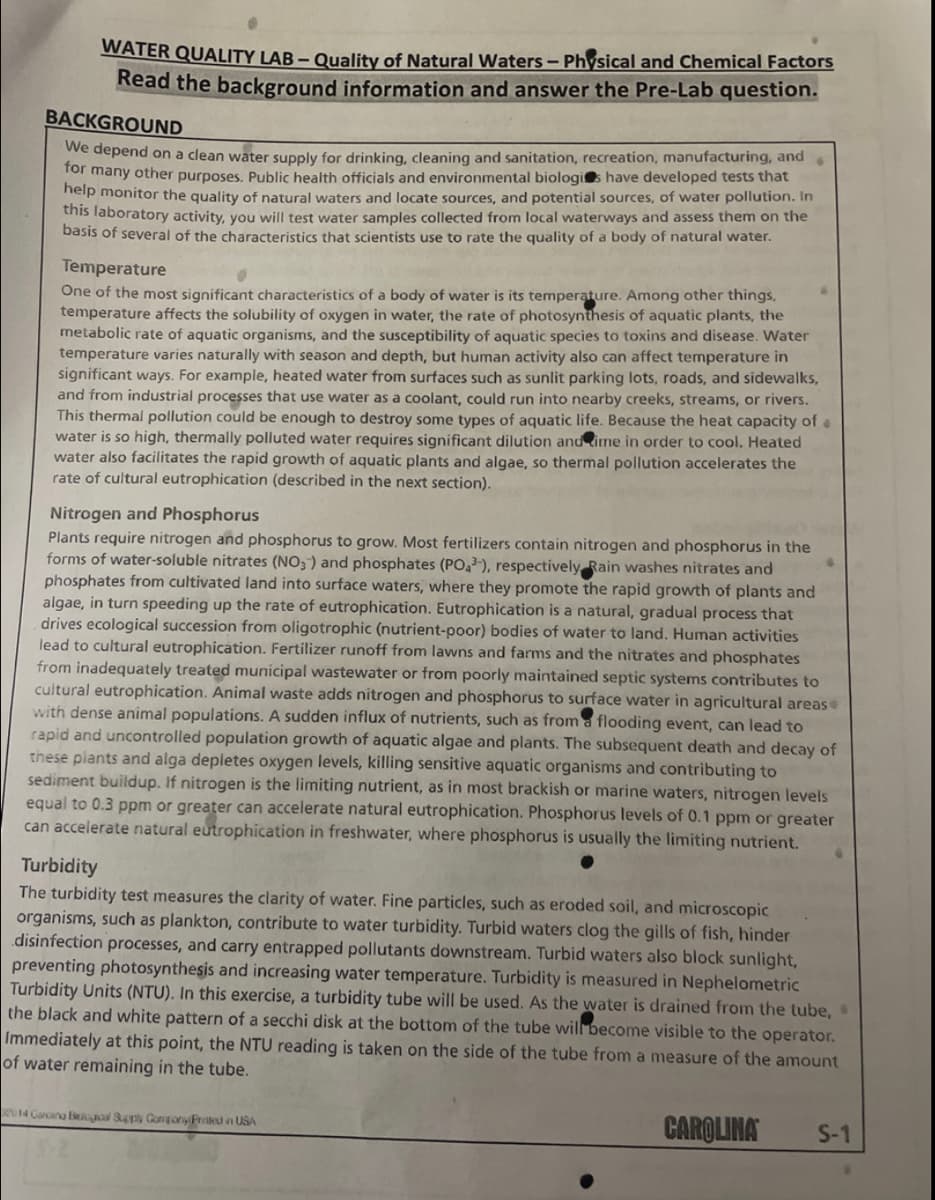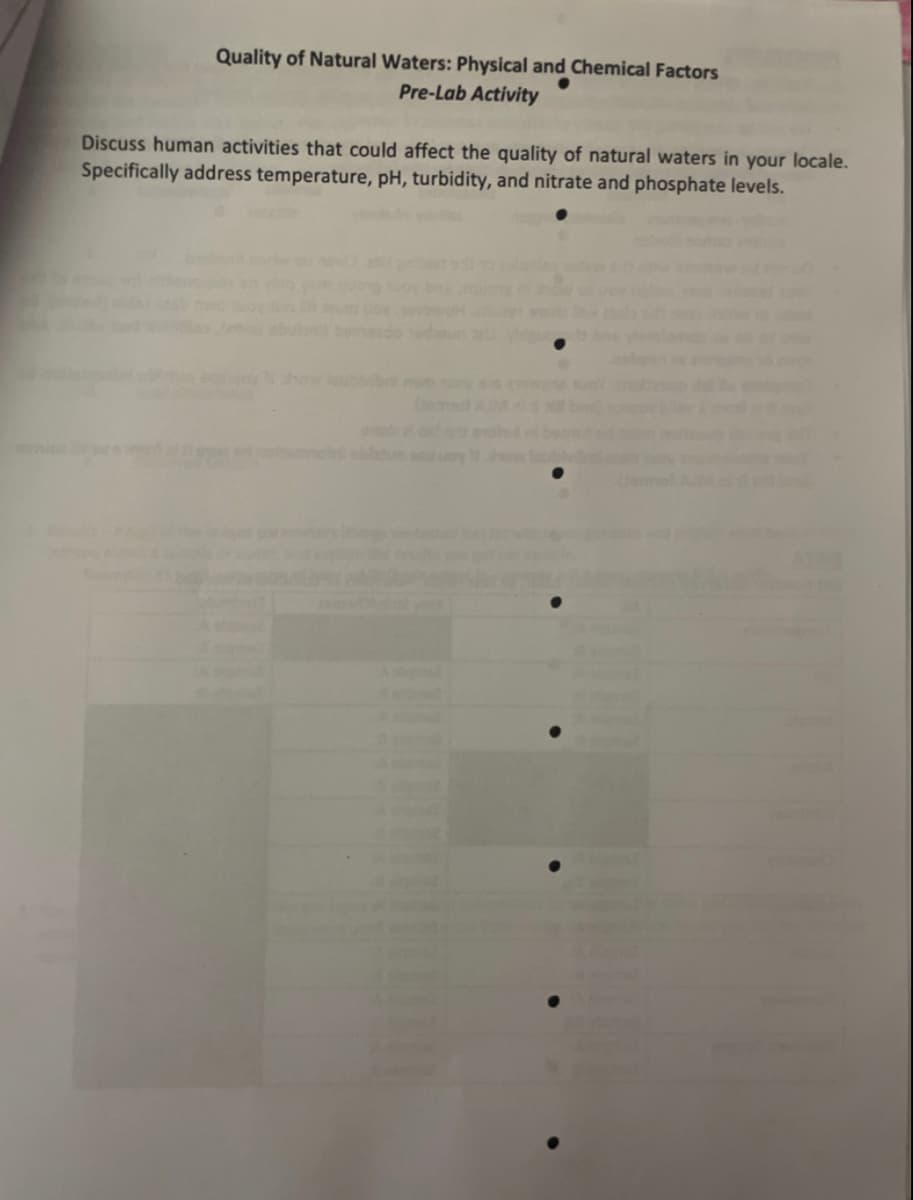Discuss human activities that could affect the quality of natural waters in your locale. Specifically address temperature, pH, turbidity, and nitrate and phosphate levels.
Discuss human activities that could affect the quality of natural waters in your locale. Specifically address temperature, pH, turbidity, and nitrate and phosphate levels.
Chapter15: Recirculating Systems
Section: Chapter Questions
Problem 1KA
Related questions
Question

Transcribed Image Text:WATER QUALITY LAB – Quality of Natural Waters – Physical and Chemical Factors
Read the background information and answer the Pre-Lab question.
BACKGROUND
We depend on a clean water supply for drinking, cleaning and sanitation, recreation, manufacturing, and
for many other purposes. Public health officials and environmental biologis have developed tests that
help monitor the quality of natural waters and locate sources, and potential sources, of water pollution. In
this laboratory activity, you will test water samples collected from local waterways and assess them on the
basis of several of the characteristics that scientists use to rate the quality of a body of natural water.
Temperature
One of the most significant characteristics of a body of water is its temperature. Among other things,
temperature affects the solubility of oxygen in water, the rate of photosynthesis of aquatic plants, the
metabolic rate of aquatic organisms, and the susceptibility of aquatic species to toxins and disease. Water
temperature varies naturally with season and depth, but human activity also can affect temperature in
significant ways. For example, heated water from surfaces such as sunlit parking lots, roads, and sidewalks,
and from industrial processes that use water as a coolant, could run into nearby creeks, streams, or rivers.
This thermal pollution could be enough to destroy some types of aquatic life. Because the heat capacity of a
water is so high, thermally polluted water requires significant dilution andime in order to cool. Heated
water also facilitates the rapid growth of aquatic plants and algae, so thermal pollution accelerates the
rate of cultural eutrophication (described in the next section).
Nitrogen and Phosphorus
Plants require nitrogen and phosphorus to grow. Most fertilizers contain nitrogen and phosphorus in the
forms of water-soluble nitrates (NO3) and phosphates (PO,), respectively Rain washes nitrates and
phosphates from cultivated land into surface waters, where they promote the rapid growth of plants and
algae, in turn speeding up the rate of eutrophication. Eutrophication is a natural, gradual process that
drives ecological succession from oligotrophic (nutrient-poor) bodies of water to land. Human activities
lead to cultural eutrophication. Fertilizer runoff from lawns and farms and the nitrates and phosphates
from inadequately treated municipal wastewater or from poorly maintained septic systems contributes to
cultural eutrophication. Animal waste adds nitrogen and phosphorus to surface water in agricultural areas
with dense animal populations. A sudden influx of nutrients, such as from a flooding event, can lead to
rapid and uncontrolled population growth of aquatic algae and plants. The subsequent death and decay of
these plants and alga depletes oxygen levels, killing sensitive aquatic organisms and contributing to
sediment buildup. If nitrogen is the limiting nutrient, as in most brackish or marine waters, nitrogen levels
equal to 0.3 ppm or greater can accelerate natural eutrophication. Phosphorus levels of 0.1 ppm or greater
can accelerate natural eutrophication in freshwater, where phosphorus is usually the limiting nutrient.
Turbidity
The turbidity test measures the clarity of water. Fine particles, such as eroded soil, and microscopic
organisms, such as plankton, contribute to water turbidity. Turbid waters clog the gills of fish, hinder
disinfection processes, and carry entrapped pollutants downstream. Turbid waters also block sunlight,
preventing photosynthesis and increasing water temperature. Turbidity is measured in Nephelometric
Turbidity Units (NTU). In this exercise, a turbidity tube will be used. As the water is drained from the tube,
the black and white pattern of a secchi disk at the bottom of the tube will become visible to the operator.
Immediately at this point, the NTU reading is taken on the side of the tube from a measure of the amount
of water remaining in the tube.
014 Carcana B a Congory Proted n USA
CAROLINA
S-1

Transcribed Image Text:Quality of Natural Waters: Physical and Chemical Factors
Pre-Lab Activity
Discuss human activities that could affect the quality of natural waters in your locale.
Specifically address temperature, pH, turbidity, and nitrate and phosphate levels.
Expert Solution
This question has been solved!
Explore an expertly crafted, step-by-step solution for a thorough understanding of key concepts.
This is a popular solution!
Trending now
This is a popular solution!
Step by step
Solved in 2 steps

Knowledge Booster
Learn more about
Need a deep-dive on the concept behind this application? Look no further. Learn more about this topic, biology and related others by exploring similar questions and additional content below.Recommended textbooks for you

